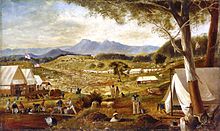
Back Febre de l'or a Austràlia Catalan Australischer Goldrausch German Fiebres del oro en Australia Spanish Australiako urre sukarra Basque تب طلای استرالیا Persian Ruées vers l'or en Australie French הבהלה לזהב (אוסטרליה) HE Demam emas Australia ID Kerubut emas Australia Malay Australian gold rushes SIMPLE
 Gold diggings, Ararat, Victoria, by Edward Roper, 1854 | |
| Date | May 1851 – c. 1914 |
|---|---|
| Location | Australia |
| Type | Gold rush |
| Theme | Significant numbers of workers (both from other areas within Australia and from overseas) relocated to areas in which gold had been discovered |
| Cause | prospector Edward Hargraves claimed to have discovered payable gold near Orange |
| Outcome | Changed the convict colonies into more progressive cities with the influx of free immigrants; Western Australia joined Federation |
| This article is part of a series on the |
| Eureka Rebellion |
|---|
 |
|
|
During the Australian gold rushes, starting in 1851, significant numbers of workers moved from elsewhere in Australia and overseas to where gold had been discovered. Gold had been found several times before, but the colonial government of New South Wales (Victoria did not become a separate colony until 1 July 1851) had suppressed the news out of the fear that it would reduce the workforce and destabilise the economy.[1]
The Australian gold rushes changed the convict colonies into more progressive cities with the influx of free immigrants.
After the California Gold Rush began in 1848, many people went there from Australia, so the New South Wales government sought approval from the British Colonial Office for the exploitation of mineral resources, and offered rewards for finding gold.[2]
- ^ "Keep it quiet!". The Examiner. Launceston, Tasmania. 15 February 1934. p. 6. Archived from the original on 2 July 2021. Retrieved 14 February 2012 – via National Library of Australia.
- ^ "The Gold Rush". Website. NSW Government. 29 June 2007. Archived from the original on 15 December 2012. Retrieved 27 October 2012.